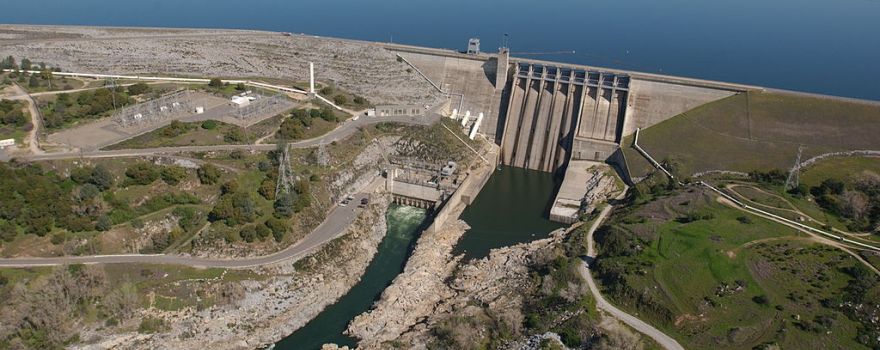 Part II: How Much Water Was Lost this Spring 2019?
Part II: How Much Water Was Lost this Spring 2019?
This commentary was written by Robert Shibatani.
In Part I of this series, we looked at the daily operations of Folsom Reservoir this past winter from January through March to see how much water from the reservoir was released or lost from the system as “spills”. Here in Part II, we address the same daily operations of Folsom Reservoir for the primary spring months of April and May.
Figure 1 shows the daily operations of Folsom Reservoir for April 2019, specifically, reservoir inflow, power releases, and spills.

The month of May proved even more illustrative. Incident precipitation was still a significant factor in generating runoff response in the upper American River watershed with almost 3.9 inches of precipitation. Figure 2 shows the temporal sequencing between reservoir inflow, power releases, and spills. Reservoir inflow was averaging approximately 9,400 cfs/day; power releases again, were being fairly constant at around 5,400 cfs/day.

Cumulative spills through the end of May was 913,790 AF. (see Figure 3) Accepting the fact that this is a very wet year, nevertheless, this amount of “spillage”, over 93% of the entire storage capacity of the reservoir, represents a significant amount of water. Moreover, power releases, averaging 5,400 cfs was well above instream flow needs for the winter/spring under any of the numerous flow targets that have been developed over the years (including the LAR FMS).
It cannot be underemphasized that these conditions represent more the norm than the exception. In both “normal” and “dry” years, spillage occurs; not due to any wanton disregard by the operators, but rather because the system’s capacity simply does not give operators the choice of carrying higher storage deep into the flood season. With highly seasonal precipitation, both rain and snowmelt combine to produce the annual hydrograph event of the year or, spring freshet, which regularly requires spillage from Folsom as well as many other reservoirs.
With all of this occurring, it is nonetheless virtually assured that someone, somewhere within the CVP “service area” will receive less water than requested or under their contracts. Indeed, many in the water resources world know that this is occurring, perhaps not all of the real-time specifics, but the supply/storage conundrum is well known.
 Figure 3: Folsom Reservoir Dam Spills – Daily and Cumulative – May 2019; Source: Reproduced from USBR/CVO Reservoir Operations Reports 2019
Figure 3: Folsom Reservoir Dam Spills – Daily and Cumulative – May 2019; Source: Reproduced from USBR/CVO Reservoir Operations Reports 2019
The kind of evidence shown here simply reinforces the notion that the State, particularly in the Sierra Nevada and southern Cascade regions, generates more water than the State needs. Because of its snow and winter rain dominance, timing is the critical issue. And timing leads to storage constraints; the seasonal timing of available water (rain/snowmelt) put simply, is too rapid and at such magnitudes that storage capacities of our existing reservoir system are easily exceeded thus warranting spilling, sometimes extensive spilling.
The example shown here is a microcosm of the larger endemic problem with water supply security in California. And Folsom is only one reservoir among the State’s many operationally controlled dams. Unfortunately, the general public is often unwittingly left uninformed of what California’s real annual water balance looks like. And with rumor and narrative broadly disseminated through influential media, it is a challenge to maintain the factual story amid all the noise.
California has water resource challenges but let’s be absolutely clear, incident precipitation (or a lack thereof) is not one of them. Three critical facts define California’s water resource management profile:
- manageable annual yield as a percentage of gross incident precipitation is unacceptably low (this speaks directly to the storage problem);
- the spatial supply/demand dichotomy results in an inordinate amount of time arguing over conveyance (including tunnels); and,
- many regulatory agencies continue to remain unsympathetic to carryover constraints and push for antiquated release triggers and downstream flow targets.
About the Author
Robert Shibatani is a consulting hydrologist and water industry advisor with over 35-years combined experience in research, environmental analysis, consulting and expert witness litigation across the globe. He is CEO of The SHIBATANI GROUP, Inc. based in Sacramento, California. <robert@theshibatanigroup.com>
[1] Reservoir inflows are computed from the sum of change in storage, all releases, pumping plant and evaporation.
[2] Ibid
[3] Reservoir inflows are computed from the sum of change in storage, all releases, pumping plant and evaporation.
The views expressed in this commentary are the author’s and not necessarily those of Maven’s Notebook.
 Sign up for daily email service and you’ll never miss a post!
Sign up for daily email service and you’ll never miss a post!
Sign up for daily emails and get all the Notebook’s aggregated and original water news content delivered to your email box by 9AM. Breaking news alerts, too. Sign me up!

